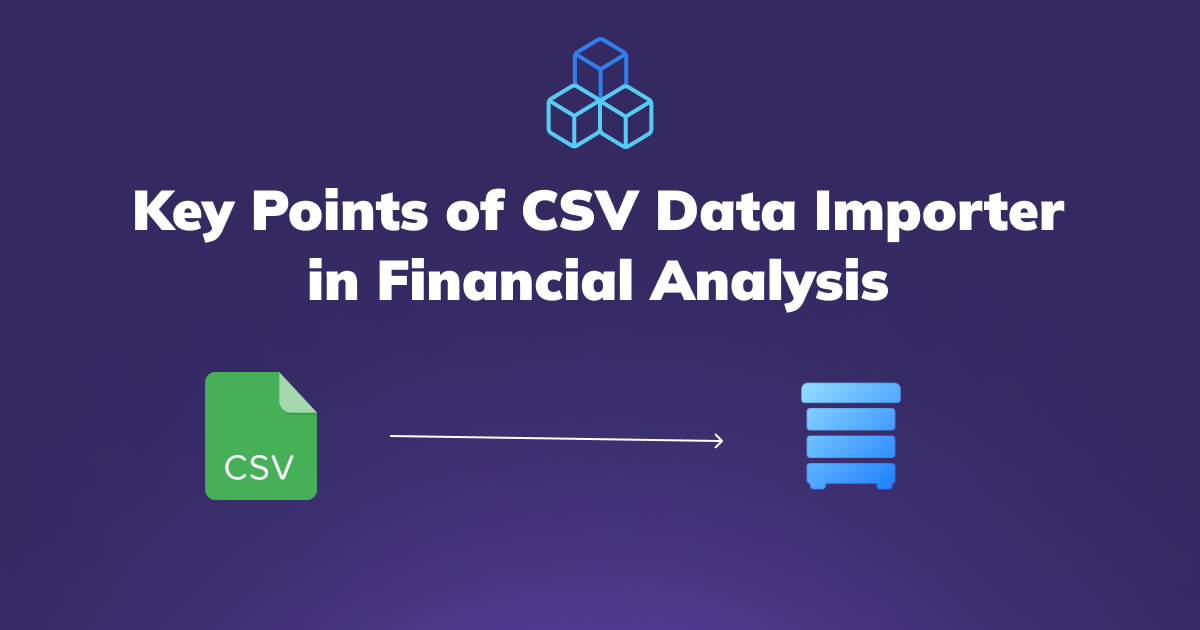Unveiling the Power of Embeddable CSV Data Importer in Financial Analysis

As the digital age continues to evolve, data has emerged as a vital asset for businesses, especially within the realm of financial analysis. Accurate data analysis informs decisions, drives strategies, and can spell the difference between success and failure.
One of the most effective tools for managing and analyzing large sets of financial data is the use of embeddable CSV data importers.
This blog post will delve into the transformational benefits, myriad applications, and implementation strategies for embeddable CSV data importers in financial analysis.
Understanding CSV Files in Financial Analysis
CSV (Comma Separated Values) is a file format that has long been the backbone of data handling across various platforms. These files store tabular data (numbers and text) in plain text, which makes them incredibly versatile.
Every line of a CSV file corresponds to a row in the table, and each comma signifies a boundary between separate values. This format's simplicity allows for easy data transfer between programs that operate on different platforms.
Financial analysts frequently handle large CSV files containing various datasets such as stock prices, investment portfolios, expense reports, and more. Analyzing this data traditionally required manually importing the CSV files into financial analysis software - a cumbersome and error-prone process. This is where embeddable CSV data importers come into the picture.
What is an Embeddable CSV Data Importer?
An embeddable CSV data importer is a sophisticated tool or plugin that allows users to upload, read, and manage CSV files directly within a web application or a software interface. It automates data import processes and ensures seamless integration of data from CSV files into the analytic framework.
These tools are designed to be highly flexible and customizable, making them easy to integrate with various software environments. They facilitate quick data ingestion and ensure that the imported data is formatted correctly and accurately, thereby minimizing the risk of errors.
Key Features of Embeddable CSV Data Importers
Before we delve into the uses, let's explore some of the standout features of embeddable CSV data importers that make them indispensable in financial analysis:
- Data Validation: These tools perform comprehensive checks to ensure that the data being imported is valid and free of errors. Data validation includes checking for required fields, formatting, and data type consistency.
- Automated Data Mapping: Embeddable importers can automatically map CSV columns to appropriate fields in the target database or software. This reduces manual configuration and speeds up the data import process.
- Scalability: These tools are designed to handle large datasets efficiently. Whether you're dealing with thousands or millions of rows, embeddable CSV data importers can manage the load effectively.
- Real-Time Processing: Many importers support real-time data processing, which means that as soon as data is uploaded, it can be immediately used for analysis, ensuring timely insights.
- Error Handling and Logging: In case of any errors during the import process, these tools provide detailed logging and error reports, allowing you to quickly identify and rectify issues.
The Transformational Benefits for Financial Analysts
Utilizing an embeddable CSV data importer in financial analysis can bring about numerous transformational benefits:
- Increased Efficiency: Manual data entry and import processes can be extremely time-consuming. With an embeddable CSV data importer, analysts can automate the import process, thereby freeing up valuable time to focus on data analysis and strategy formulation.
- Enhanced Accuracy: Manual data entry is prone to human errors, which can lead to inaccurate analysis and misguided decision-making. Automated importers ensure that data is accurately imported, reducing the risk of errors and enhancing the reliability of the data.
- Real-Time Analysis: Financial markets are dynamic, and timely data analysis is crucial. Embeddable CSV data importers enable real-time data import and analysis, allowing analysts to make timely and informed decisions.
- Improved Data Integration: Financial analysis often involves integrating data from multiple sources. These tools facilitate seamless data integration, enabling analysts to create comprehensive and holistic views of financial datasets.
- Customizability: These importers can be customized to meet specific business needs, allowing for tailored data import processes that align with organizational requirements.
Applications of Embeddable CSV Data Importers in Financial Analysis
Now, let’s explore some practical applications of embeddable CSV data importers in financial analysis:
- Portfolio Management: Managing a diversified portfolio requires analyzing data from various sources, including stocks, bonds, mutual funds, and other financial instruments. With an embeddable CSV data importer, portfolio managers can easily integrate data from different CSV files, providing a consolidated view of the entire portfolio. This enables more effective risk assessment, performance tracking, and rebalancing decisions.
- Performance Tracking: Financial analysts can use embeddable CSV data importers to regularly upload performance data, such as monthly or quarterly returns, into their analysis software. This allows for continuous monitoring and evaluation of investment performance, helping analysts to identify trends, opportunities, and potential issues promptly.
- Trend Analysis: Trend analysis involves studying historical data to identify patterns and predict future movements. By using an embeddable CSV data importer, analysts can effortlessly load historical financial data into their analysis tools. This facilitates the identification of long-term trends and supports more accurate forecasting and strategic planning.
- Financial Modelling: Financial models are essential for predicting financial performance and assessing the impact of different scenarios. Embeddable CSV data importers streamline the process of loading financial data into modelling software. This ensures that the models are built using up-to-date and accurate data, leading to more reliable predictions and insights.
- Regulatory Reporting: Financial institutions are required to submit various regulatory reports to comply with industry regulations. Embeddable CSV data importers facilitate the automatic import of financial data into reporting templates, ensuring that reports are prepared accurately and promptly, thereby aiding in compliance management.
- Expense Tracking and Analysis: For corporate finance teams, tracking and analyzing expenses is crucial for budget management and cost control. By using embeddable CSV data importers, finance teams can seamlessly import expense data from various departments and systems. This enables comprehensive expense analysis, helping organizations to identify cost-saving opportunities and optimize their budgets effectively.
- Real-Time Data Analysis for Trading: In the fast-paced world of trading, real-time data analysis is critical. Traders can use embeddable CSV data importers to instantly load market data, news feeds, and financial indicators into their trading platforms. This allows for real-time analysis and quick decision-making, essential for capitalizing on market movements and opportunities.
Implementation Strategies for Financial Analysts
Implementing an embeddable CSV data importer into your financial analysis workflow requires careful planning and execution. The following strategies can help ensure a smooth and successful implementation:
- Assess Your Requirements: Begin by assessing your specific data import needs. Consider the volume of data you handle, the frequency of data imports, and the types of analyses you perform. This will help you choose an embeddable CSV data importer that aligns with your requirements.
- Choose the Right Importer: There are various embeddable CSV data importers available in the market, each with its own set of features and capabilities. Research and compare different options to find the one that best meets your needs. Consider factors such as ease of integration, scalability, data validation features, and support for real-time processing.
- Plan the Integration: Once you have chosen an importer, plan the integration process carefully. Identify the data sources, target systems, and integration points. Define the data mapping rules, validation criteria, and error handling procedures. A well-planned integration minimizes potential disruptions and ensures a smooth transition.
- Test Extensively: Before deploying the importer in a production environment, conduct extensive testing. Test the import process with different types of CSV files and scenarios to ensure that the data is imported accurately and efficiently. Address any issues or gaps identified during testing to ensure a seamless import process.
- Train Your Team: Provide training to your financial analysts and relevant team members on how to use the embeddable CSV data importer effectively. Ensure that they understand the import process, data validation criteria, and error handling procedures. Well-trained users can leverage the importer's features to their full potential and minimize errors.
- Monitor and Optimize: After deployment, continuously monitor the import process to ensure that it is functioning as expected. Collect feedback from users and address any issues promptly. Consider optimizing the importer configuration based on usage patterns and performance metrics to enhance efficiency and effectiveness.
Conclusion
Incorporating an embeddable CSV data importer into financial analysis workflows represents a significant step towards modernizing and optimizing data handling processes. These tools bring numerous benefits, including increased efficiency, enhanced accuracy, real-time analysis, improved data integration, and customizability.
Financial analysts can leverage embeddable CSV data importers for various applications, including portfolio management, performance tracking, trend analysis, financial modelling, regulatory reporting, expense tracking, and real-time data analysis for trading.
By carefully assessing requirements, choosing the right importer, planning integration, testing extensively, training the team, and monitoring the process, financial analysts can ensure a successful implementation. Ultimately, embeddable CSV data importers empower financial analysts to harness the full potential of their data, leading to more informed decision-making and a competitive edge in the financial landscape.
In the rapidly evolving world of finance, the ability to efficiently manage and analyze data is paramount. As technology continues to advance, tools like embeddable CSV data importers will play an increasingly vital role in shaping the future of financial analysis. Embrace the power of automation and data integration to unlock new levels of insight, efficiency, and success in your financial endeavours.

